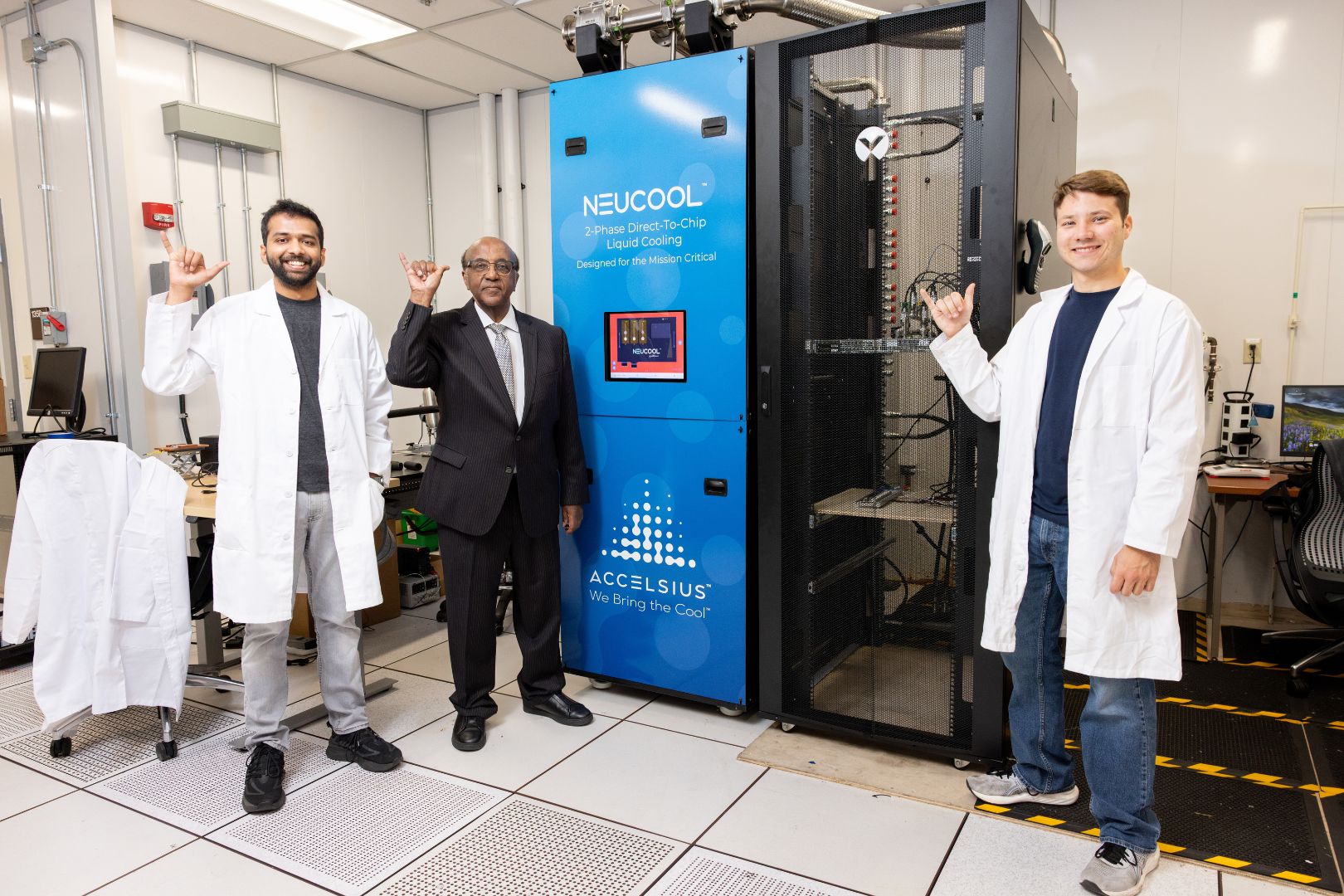UTA leads charge to solve AI data centers’ energy crisis

As demand for generative artificial intelligence chatbots like ChatGPT rapidly grows, so does the need for water and energy to cool and power the massive data centers that support them. Existing facilities routinely exceed hundreds of megawatts, with multi-gigawatt campuses under development. These large-scale data centers are being built swiftly across the U.S., including several large-scale facilities in North Texas.
In 2024, the Electric Power Research Institute estimated that U.S. data centers could consume up to 9% of the nation's total electricity by 2030, driven largely by the growth of AI and digital infrastructure. In Texas, data center electricity use could more than double, rising from 4.6% in 2023 to nearly 11% by 2030.
That’s why the Department of Energy’s ARPA-E COOLERCHIPS program selected University of Texas at Arlington Presidential Distinguished Professor Dereje Agonafer to lead a critical effort to reduce cooling energy consumption to less than 5% of a data center's information technology load. Currently, cooling systems can account for as much as 40% of a data center's total energy consumption. In addition to electricity, many data centers rely heavily on water for evaporative cooling—often using hundreds of thousands of gallons per day per facility.
A member of the National Academy of Engineering, Dr. Agonafer is collaborating with researchers from the University of Maryland, the University of Illinois Urbana-Champaign and the Illinois Institute of Technology to tackle this challenge.
.jpg?revision=36d55c9f-ffa9-47a7-b687-dd0a8013ca20)
Agonafer recently secured a key partnership with Austin-based Accelsius, a leader in two-phase, direct-to-chip liquid cooling, to advance this time-sensitive project. Accelsius will support system-level testing by providing its proprietary MR250 technology—a multi-rack, in-row, 250-kilowatt, two-phase Coolant Distribution Unit (2P CDU), along with comprehensive integration support. “We are benefiting greatly from being part of what people call the ground zero of liquid cooling,” Richard Bonner, CTO of Accelsius, said in a recent LinkedIn interview.
As AI workloads grow, racks of servers in data centers are packed more densely with powerful hardware that generates significant heat. Traditional air cooling can no longer keep up, leading to environmental and quality-of-life concerns for people living near newly built mega-data centers.
“The computing power needed to support AI is growing at an exponential rate,” Agonafer said. “If we don’t find smarter, more efficient ways to cool data centers, the environmental impact will be significant. Our goal is to deliver a scalable solution that is both energy-efficient and environmentally responsible.”
Related: UTA powers smarter microgrids with new converter tech
In Texas—where dozens of new data centers are in development—communities are experiencing increased strain on power grids, rising air and noise pollution and worries over water use in drought-prone regions. In Fort Worth, a proposed 121-acre, five-building data center project at Rock Creek Ranch drew public backlash over zoning, with residents citing potential noise, light pollution and environmental justice concerns due to its proximity to residential neighborhoods.
Despite community concerns, the project moved forward—underscoring the growing tension between economic development and quality-of-life issues.
At UTA, Agonafer’s team is working to advance next-generation thermal management technologies that can meet the rising energy and cooling demands of high-performance computing and AI workloads. Their research focuses on developing new cooling technologies that reduce both energy and water consumption, contributing to more sustainable data center operations.
Related: UT Arlington-UT Austin team win prize for vital U.S. magnet technology
As AI applications continue to scale, resource demands are expected to rise sharply, intensifying concerns about sustainability and environmental impact. This makes energy and water-efficient cooling solutions not just beneficial, but essential to the future of digital infrastructure.
The project also highlights UTA’s commitment to giving students opportunities to engage in high-level, real-world research while pursuing their degrees.
Graduate students Sai Pundla and Braxton Smith, who work under Agonafer, said the project gives them hands-on experience in advanced thermal management and system integration—skills critical to building sustainable data centers in the future.
“Being part of this project has been an incredible opportunity to apply what I’ve learned in the lab to a real-world challenge with global implications,” Smith said.
About The University of Texas at Arlington (UTA)
Celebrating its 130th anniversary in 2025, The University of Texas at Arlington is a growing public research university in the heart of the thriving Dallas-Fort Worth metroplex. With a student body of over 41,000, UTA is the second-largest institution in the University of Texas System, offering more than 180 undergraduate and graduate degree programs. Recognized as a Carnegie R-1 university, UTA stands among the nation’s top 5% of institutions for research activity. UTA and its 280,000 alumni generate an annual economic impact of $28.8 billion for the state. The University has received the Innovation and Economic Prosperity designation from the Association of Public and Land Grant Universities and has earned recognition for its focus on student access and success, considered key drivers to economic growth and social progress for North Texas and beyond.